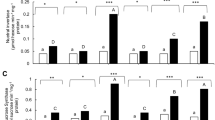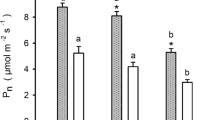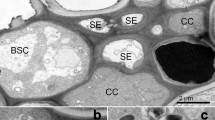Summary
Intermediates involved in carbon partitioning between starch and sucrose [dihydroxyacetone phosphate + glyceraldehyde 3-phosphate (TP), 3-phosphoglyceric acid, fructose 6-phosphate (F6P), fructose 2,6-bisphosphate (F26BP), in addition to glucose, fructose, sucrose and starch] were analysed in lyophilized needles of Norway spruce (Picea abies L. Karst). Samples were taken from all distinct parts of first and second order branches and the analysed data related to season, needle age, needle position and degree of needle loss (control and class 2 approx. 30%–40% needle loss). Positive and inverse correlations of F26BP, an important regulator of carbon partitioning between starch and sucrose, and F6P or TP existed in all samples. F26BP levels were highest in developing needles and gradually decreased during maturation, which is possibly indicative of changes in the relative sink strength during development (switch from import to export of sucrose). In class 2 needles the amount of F26BP was significantly increased. Together with nearly unaltered levels of sucrose but only slightly decreased amounts of starch the results can be taken as evidence for impaired carbon export in our class 2 samples. The data are discussed with respect to needle development and a possible impact of both air pollutants and mineral deficiency at the location from which the samples were taken.
Similar content being viewed by others

References
Dekker RFM, Richards GN (1971) Determination of starch in plant material. J Sci Food Agric 22: 441–444
Ericsson A (1979) Effects of fertilization and irrigation on the seasonal changes of carbohydrate reserves in different age-classes of needle on 20-year-old Scots pine trees (Pinus sylvestris). Physiol Plant 45: 270–280
Fink S (1988) Histologische und histochemische Untersuchungen zur Nährstoffdynamik in Waldbäumen im Hinblick auf die “Neuartigen Waldschäden”. Kernforschungszentrum Karlsruhe, KfK-PEF 35: 209–218
Gerhardt R, Stitt M, Heldt HW (1987) Subcellular metabolite levels in spinach leaves. Regulation of sucrose synthesis during diurnal alterations in photosynthesis. Plant Physiol 83: 399–407
Giaquinta RT (1983) Phloem loading of sucrose. Annu Rev Plant Physiol 34: 347–387
Hampp R, Goller M, Füllgraf H (1984) Determination of compartmented metabolite pools by a combination of rapid fractionation of oat mesophyll protoplasts and enzymic cycling. Plant Physiol 75: 1017–1021
Herzog B, Stitt M, Heldt HW (1984) Control of photosynthetic sucrose synthesis by fructose 2,6-bisphosphate. III. Properties of the cytosolic fructose 1,6-bisphosphatase. Plant Physiol 75: 561–565
Jones MGK, Outlaw WH (1981) Enzymic assay for sucrose. In: Kornberg HL (ed) Technics in carbohydrate metabolism, B302 Elsevier, Amsterdam, pp 1–8
Kerr P, Huber SC (1987) Coordinate control of sucrose synthesis in soybean leaves by sucrose phosphate synthase and fructose-2,6-bisphosphate. Planta 170: 197–204
Kuhn U, Beck E (1987) Conductance of needle and twig axis phloem of damaged and intact Norway spruce (Picea abies (L.) Karst.) as investigated by application of 14C in situ. Trees 1: 207–214
Lichtenthaler HK, Schmuck G, Döll M, Buschmann C (1985) Untersuchungen über die Funktionsfähigkeit des Photosyntheseapparates bei Nadeln gesunder und geschädigter Koniferen. Kernforschungszetrum Karlsruhe KfK-PEF 2: 81–105
Lowry OH, Passonneau JV (1972) A flexible method of enzymatic analysis. Academic Press, New York
Lundmark T, Hällgren J-E, Hedèn (1988) Recovery from winter depression of photosynthesis in pine and spruce. Trees 2: 110–114
Mann HB, Whitney DR (1947) On a test whether one or two random variables is stochastically larger than the other. Ann Math Statist 18: 50–60
McLaughlin SB, McConathy RK (1983) Effects of SO2 and O3 on allocation of 14C-labeled photosynthate in Phaseolus vulgaris. Plant Phys 73: 630–635
Minchin PEH, Gould R (1986) Effects of SO2 on phloem loading. Plant Sci 43: 179–183
Neuhaus HE, Kruckeberg AL, Feil R, Stitt M (1989) Reduced-activity mutants of phosphoglucose isomerase in the cytosol and chloroplast of Clarkia xantiana. II. Study of the mechanisms which regulate photosynthate partitioning. Planta 178: 110–122
Outlaw WH JR, Manchester J (1979) Guard cell starch concentration quantitatively related to stomatal aperture. Plant Physiol 64: 79–82
Preiss J (1988) Biosynthesis of starch and its regulation. In: Stumpf PK Conn EE (eds) The biochemistry of plants, vol 14, Academic Press, San Diego, pp 182–254
Sicher RC, Kremer DF, Harris WG (1986) Control of photosynthetic sucrose synthesis in barley primary leaves. Plant Physiol 82: 15–18
Steingraber M, Outlaw WH Jr, Hampp R (1988) Subcellular compartmentation of fructose 2,6-bisphosphate in oat mesophyll cells. Planta 175: 204–208
Stitt M (1987) Fructose 2,6-bisphosphate and plant carbohydrate metabolism. Plant Physiol 84: 201–204
Stitt M, Cseke C, Buchanan BB (1985) Occurrence of a metabolite regulated enzyme synthesising fructose 2,6-bisphosphate in plant sink tissues. Physiol Veg 23: 819–827
Stitt M, Wilke I, Feil R, Heldt HW (1988a) Coarse control of sucrose phosphate synthase in leaves. Planta 174: 217–230
Stitt M, Woo KC, Große H (1988b) Interactions between sucrose synthesis and photosynthesis. II. Alterations of fructose-2,6-bisphosphate during photosynthetic oscillations. J Plant Physiol 133: 138–143
Van Schaftingen E (1984) D-Fructose 2,6-bisphosphate. In: Bergmeyer HU (ed) Methods of enzymatic analysis. Verlag Chemie, Weinheim, pp 335–341
Vogels K, Guderian R, Masuch G (1986) Studies on Norway spruce (Picea abies Karst.) in damaged forest stands and in climatic chambers experiments. In: Schneider T (ed) Acidification and its policy implications. Elsevier, Amsterdam, pp 171–186
Winner WE, Mooney HA, Williams K, Caemmerer S von (1985) Measuring and assessing SO2 effects on photosynthesis and plant growth. In: Winner WE, Mooney HA, Goldstein RA (eds) Sulfur dioxide and vegetation. Stanford University Press, Stanford, pp 118–139
Author information
Authors and Affiliations
Rights and permissions
About this article
Cite this article
Einig, W., Hampp, R. Carbon partitioning in Norway spruce: amounts of fructose 2,6-bisphosphate and of intermediates of starch/sucrose synthesis in relation to needle age and degree of needle loss. Trees 4, 9–15 (1990). https://doi.org/10.1007/BF00226234
Received:
Issue Date:
DOI: https://doi.org/10.1007/BF00226234



